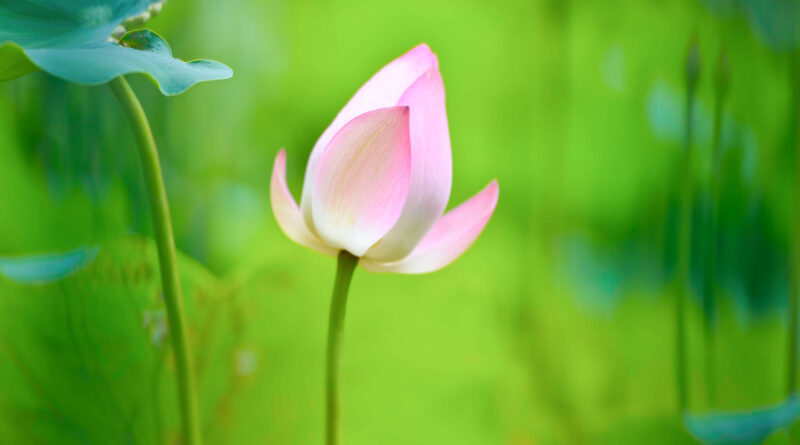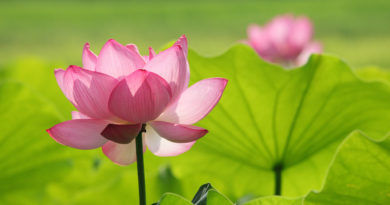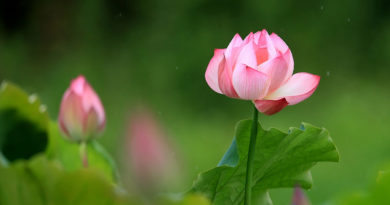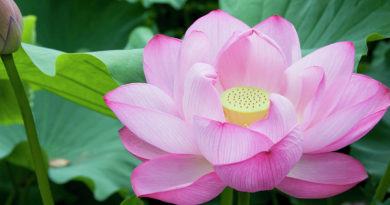ABHIDHAMMA IN DAILY LIFE – CHAPTER 16: OBJECTS AND DOORS
ABHIDHAMMA IN DAILY LIFE – CHAPTER 16: OBJECTS AND DOORS
Citta knows or experiences something, it experiences an object. There cannot be any citta without an object. When an object presents itself through one of the five senses or through the mind-door, do we realize that it is citta which experiences that object? When we do not see things as they are, we think that a self experiences objects, and, moreover, we take objects for permanent and for self. For example, when we see a log of wood, we are used to thinking that the object which is seen at that moment is the log of wood ; we do not realize that only visible object is the object which can be seen. When we touch the log of wood, hardness or cold, for example, can be experienced through the body-sense. We take the log of wood for a thing which lasts, but what we call ‘log of wood’ are many different rupas which arise and fall away. Only one characteristic of rupa can be experienced at a time, when it presents itself. If we develop our understanding to see different characteristics which appear through different doorways we will be able to see things as they really are.
The ariyan sees life in a way which is different from the way the non-ariyan sees it. What the person who is not an ariyan takes for happiness (in Pali : sukha), is for the ariyan sorrow (dukkha) ; what for the non-ariyan is sorrow, is for the ariyan happiness. In the ‘Kindred Sayings’ (IV, Salayatana-vagga, Third Fifty, Ch. IV, par. 136) it is said in a verse :
Things seen and heard, tastes, odours, what we touch,
Perceive, – – all, everything desirable,
Pleasant and sweet, while one can say ‘it is’,
These are deemed ‘sukha’ by both gods and men.
And when they cease to be they hold it woe.
The dissolution of the body-self
To ariyans seems ‘sukha’. Everything
The world holds good, sages see otherwise.
What other men call ‘sukha’, that the saints
Call ‘dukkha’ what the rest so name,
That do the Ariyans know as happiness.
Behold a Dhamma that’s hard to apprehend.
Hereby are baffled they that are not wise.
Darkness is theirs, enmeshed by ignorance:
Blindness is theirs, who cannot see the light….
The Buddha taught about objects, experienced by cittas through different doors, in order to cure people of their blindness. When we study the teachings we learn that there are six classes of objects (in Pali : arammana), which can be known by citta.
The first class is : visible object or ruparammana. The object which is experienced through the eye-door can only be the kind of rupa which is visible object. We can call it visible object or colour, it does not matter how we name it, but we should know that it is just that which is visible, which appears through the eyes. Visible object is not a thing or a person we may think of. When we think that we see a tree, animal or man, we think of concepts and there is not the knowing of visible object.
The second class of arammana is sound, or saddarammana.
The third class is smell, or gandharammana.
The fourth class is taste, or rasarammana.
The fifth class is the object which is experienced through the bodysense, photthabbarammana. This object comprises the following rupas:
Solidity or the ‘Element of Earth’ (in Pali : pathavi-dhatu), which can be experienced as hardness or softness.
Temperature or the ‘Element of Fire’ (in Pali : tejo-dhatu), which can be experienced as heat or cold.
Motion or the ‘Element of wind’ (in Pali: vayo-dhatu), which can be experienced as motion or pressure.
Solidity (earth), cohesion (water), temperature (fire) and motion (wind or air) are the ‘four principal rupas’ (maha-bhuta-rupas). Cohesion (apo-dhatu) can’ t be experienced through the body-sense. When we touch water the characteristics of hardness or softness, heat or cold, motion or pressure can be directly experienced through the body-sense. The characteristic of cohesion can be experienced only through the mind-door; it is included in the sixth class of arammana, the dhammarammana.
Dhammarammana comprises all objects which are not included in the first five classes. These can be experienced only through the mind-door.
If one has not cultivated insight, one does not clearly know which object presents itself through which doorway, one is confused as to objects and doors ; thus one is confused about the world. The ariyan is not confused about the world ; he knows the arammanas which appear through the six doors as nama and rupa, not self.
The ‘Discourse on the Six Sixes’ (Middle Length Sayings III. No.148) is very helpful for the understanding of realities which present themselves through the six doors. When the Buddha ; was staying in the Jeta Grove in Anathapindika’s monastery, he explained to the monks about the six ‘internal sense-fields’ and the six ‘external sense-fields’ (in Pali : ayatana). The six ‘internal sense-fields’ are the six doors through which objects are experienced. The six ‘external sense-fields’ are the objects, experienced through the six doors. The Buddha then explained about the six classes of consciousness which arise in dependence on the six doors and about the objects experienced through the six doors. He also explained about six kinds of contact (phassa), six kinds of feeling conditioned by the six kinds of contact, and six kinds of craving conditioned by the six kinds of feeling. Thus there are ‘Six Sixes’, six groups of six realities.
The Buddha then explained about the person who has attachments, aversion or ignorance with regard to what he experiences through the six doors. We read :
‘Monks, visual consciousness arises because of eye and visible object, the meeting of the three is contact ; an experience arises conditioned by contact that is pleasant or painful or neither painful nor pleasant. He, being impinged on by a pleasant feeling, delights, rejoices and persists in cleaving to it ; a tendency to attachment is latent in him. Being impinged on by a painful feeling, he grieves, mourns, laments, beats his breast and falls into disillusion ; a tendency to repugnance is latent in him. Being impinged on by a feeling that is neither painful nor pleasant, he does not comprehend the origin nor the going down nor the satisfaction nor the peril of that feeling nor the escape from it as it really is ; a tendency to ignorance is latent in him…’
The same is said with regard to the other doorways.
The person who has ‘wise attention’ instead of attachment, aversion or ignorance can make an end to the cycle of birth and death, Further on we read :
‘… He, being impinged on by pleasant feeling, does not delight, rejoice or persist in cleaving to it; a tendency to attachment is not latent in him. Being impinged on by a painful feeling, he does not grieve, mourn, lament, beat his breast or fall into disillusion ; a tendency to repugnance is not latent in him. Being impinged on by a feeling that is neither painful nor pleasant, he comprehends the origin and the going down and the satisfaction and the peril of that feeling and the escape as it really is, a tendency to ignorance is not latent in him. That he, monks, by getting rid of any tendency to attachment to a pleasant feeling, by driving out any tendency to repugnance for a painful feeling, by rooting out any tendency to ignorance concerning a feeling that is neither painful nor pleasant, by getting rid of ignorance, by making knowledge arise, should here and now be an end-maker of dukkha–this situation exists.
Seeing this thus, monks, the instructed disciple of the ariyans turns away from eye, turns away from material shapes, turns away from visual consciousness, turns away from impact on the eye, turns away from feeling, turns away from craving. He turns away from ear, he turns away from sounds…. He turns away from nose, he turns away from smells…. He turns away from tongue, he turns away from tastes…. He turns away from body, he turns away from touches…. He turns away from mind, he turns away from mental states, he turns away from mental consciousness, he turns away from impact on the mind, he turns away from feeling, he turns away from craving, Turning away he is dispassionate ; by dispassion he is freed ; in freedom is the knowledge that he is freed, and he comprehends : Destroyed is birth, brought to a close the Brahma-faring, done is what was to be done, there is no more of being such or so .’
Thus spoke the Lord. Delighted, these monks rejoiced in what the Lord had said. And while this exposition was being given the minds of as many as sixty monks were freed from the cankers without grasping.’
As regards dhammarammana, the sixth class of arammana, this can again be subdivided into six classes.
They are :
- The five sense-organs (pasada-rupas)
2. The sixteen subtle rupas (sukhuma-rupas)
3. Citta
4. Cetasika
5. Nibbana
6. Conventional terms or concepts (pannatti)
The first class of dhammarammana comprises the five sense-organs (pasada-rupas) ; they are the rupas which have the capacity to receive sense-impressions. The pasada-rupas do not experience anything, they are rupa, not nama ; they can be the doors through which cittas experience objects. The pasada-rupas cannot be known through the sense-doors; they can only be known through the mind-door. For example, we cannot experience eye-sense through the eyes ; we know that there is eye-sense, because there is seeing.
As regards the ‘subtle rupas’ (sukhuma-rupas), there are sixteen kinds of subtle rupa. Altogether there are twenty-eight kind of rupa of which twelve are classified as ‘gross’ (olarika) and sixteen as subtle (sukhuma). .
The gross rupas include the seven objects which can be directly experienced through the five sense-doors : four rupas though the four sense-doors of eyes, ears, nose and tongue respectively, and the three rupas of solidity, temperature and motion through the body-door. Furthermore there are the gross rupas which are the five senses (pasada-rupas), the rupas which can be the doors through which these objects are experienced. The five pasada-rupas are classified as the first class of dhammarammana.
The sixteen kinds of subtle rupa can be experienced only through the mind-door. Among them are, for example, ‘nutritive essence’ (oja), vaci-vinnatti, the rupa which is the physical condition for speech, and kaya-vinnatti, the rupa which is the physical condition for expression through gestures (bodily expression).
It depends on the accumulated panna whether the true nature of subtle rupas can be experienced or not. When one thinks about one of the subtle rupas it does not mean that there is panna which directly experiences its characteristic, as only a kind of rupa, not self.
Citta is another class of dhammarammana cittas experience different arammanas, but citta itself can be arammana as well. Citta can have kusala cittas, akusala cittas and many other types of citta as its object.
The class of dhammarammana which is cetasika comprises all fifty-two cetasikas. Feeling is a cetasika. Painful feeling, for example, can be known by citta ; then the object of citta is dhammarammana. When one experiences hardness the object is not dhammarammana but phothabbarammana (tangible object). Hardness and painful bodily feeling can appear closely one after the other. If one does not realize that hardness and painful bodily feeling are different arammanas and if one is ignorant of the different characteristics of nama and rupa, one will continue taking them for self.
Citta can experience all kinds of objects. Even nibbana can be experienced by citta. Nibbana is dhammarammana, it can only be experienced through the mind-door. Thus, citta can experience both sankhara dhammas (conditioned dhammas) and visankhara dhamma (unconditioned dhamma). The citta which experiences sankhara dhamma is lokiya citta (lokiya is usually translated as ‘mundane’, but it does not mean ‘worldly’ as it is understood in conventional language). The citta which directly experiences nibbana is lokuttara citta.
Another class of dhammarammana is conventional terms, concepts and ideas (pannatti). Thus we see that citta can know both paramattha dhammas, which are nama and rupa, and concepts or conventional terms, which are not paramattha dhammas.
A concept or a conventional term citta thinks of is not a paramattha dhamma. We can think of a person, an animal or a thing because of remembrance of past experiences, but they are not paramattha dhammas, realities which can be directly experienced. When there is thinking about a conventional term or a concept, it is nama which thinks ; nama is a paramattha dhamma. Thus, the reality at that moment is the thinking.
Conventional terms can denote both realities and things which are not real. A term which in itself is not a paramattha dhamma, can denote a paramattha dhamma. For instance, the terms ‘nama’ and ‘rupa’ are pannatti, but they denote paramattha dhammas. It is essential to know the difference between paramattha dhamma and pannatti. If we cling to the terms ‘nama’ and ‘rupa’ and continue thinking about nama and rupa instead of being aware of their characteristics when they appear, we will only know pannattis instead of realities.
The five classes of arammana which are visible object, sound, smell, taste and bodily impressions are rupa ; the sixth class, the six kinds of dhammarammana, comprises cittas, cetasikas, pasada rupas, subtle rupas, nibbana and also pannatti.
Different objects can be experienced through different doorways (in Pali : dvara). For example, the pasada-rupa in the eye (the rupa which has the capacity to receive visible object) is a necessary condition for citta to experience visible object. If there were not pasada-rupa in the eye, citta could not experience visible object.
Cittas of the sense-door process know their objects through the doors of the eye, the ear, the nose, the tongue and the body-sense. As regards the door of the body-sense, the pasada-rupa which has the capacity to receive bodily impressions such as hardness, softness, heat, cold, motion or pressure, is any part of the body which can receive such impressions. Thus, any part of the body can be body-door, except those parts which have no sensitivity.
Five doors are rupa and one door is nama. The mind-door is nama. The cittas of the mind-door process experience an object through the mind-door. Before the mano-dvaravajjana-citta (mind-door-adverting-consciousness) arises there are the bhavanga-calana (vibrating bhavanga) and the bhavangupaccheda (arrest-bhavanga). The bhavangupaccheda, the citta preceding the mano-dvaravajjana-citta, is the mind-door. It is the ‘doorway’ through which mano-dvaravajjana-citta experiences its object.
It is useful to know through which door cittas experience different objects. For example, visible object which is ruparammana can be experienced both through the eye-door and through the mind-door. It is experienced through the eye-door when it has not fallen away yet. When it is experienced by the cittas of the mind-door process following upon that eye-door process, it has just fallen away. When visible object is experienced through the mind-door the cittas only know visible object, they do not think of a person or a thing. But time and again there are also mind-door processes of cittas which think of people or things and then the object is a concept, not visible object. The experience of visible object conditions the thinking of concepts which arises later on.
In both the sense-door process and the mind-door process, javana-cittas arise ; these javana-cittas are, if one is not an arahat, either kusala cittas or akusala cittas. When visible object is experienced through the eye-door, one does not yet perceive a person or a thing, but, already in the sense-door process, attachment to what is seen can arise, or aversion towards it, or ignorance. Defilements are deeply rooted, they can arise through all six doors. We may think that the enslavement to the objects which are experienced through the sense-doors is caused by the objects. Defilements, however, are not caused by objects, they are accumulated in the citta which experiences the object.
We read in the ‘Kindred Sayings’ (IV, Salayatana-vagga, Fourth Fifty, Ch. III, par. 191, Kotthika) that Sariputta and Maha-Kotthika were staying near Varanasi at Isipatana, in the Antelope Park. Kotthika said to Sariputta :
‘How now, friend? Is the eye the bond of objects, or are objects the bond of the eye? Is the tongue the bond of savours, or are savours the bond of the tongue? Is mind the bond of mind-objects, or are mind-objects the bond of the mind?’
‘Not so, friend Kotthika. The eye is not the bond of objects, nor are objects the bond of the eye, but that desire and lust that arise owing to these two. That is the bond. And so with the tongue and mind…it is the desire and lust that arise owing to savours and tongue, mind-objects and mind.
Suppose, friend, two oxen, one white and one black, tied by one rope or one yoke-tie. Would one be right in saying that the black ox is the bond for the white one, or that the white ox is the bond for the black one?’
‘Surely not. Friend.’
‘That is right, friend. It is not so. But the rope or the yoke-tie which binds the two, – – that is the bond that unites them. So it is with the eye and objects, with tongue and savours, with mind and mind-objects. It is the desire and lust which are in them that form the bond that unites them.
If the eye, friend, were the bond of objects, or if objects were the bond of the eye, then this righteous life for the utter destruction of dukkha, could not be proclaimed. But since it is not so, but the desire and lust which are in them is the bond, therefore is the righteous life for the utter destruction of dukkha proclaimed…
There is in the Exalted One an eye, friend. The Exalted One sees an object with the eye. But in the Exalted One is no desire and lust. Wholly heart-free is the Exalted One. There is in the Exalted One a tongue…a mind. But in the Exalted One is no desire and lust. Wholly heart-free is the Exalted One.
By this method, friend, you are to understand, as I said before, that the bond is the desire and lust which are in things.
-ooOoo-
Questions
- Through which doors can motion be experienced?
2. Through which door can body-sense be experienced?
3. What class of arammana (object) is cohesion?
4. What class of arammana is lobha-mula-citta (citta rooted in attachment?
5. Through which door can lobha-mula-citta be experienced?
6. Through which doors can lobha-mula-citta experience an object?
7. What class of arammana is cold?
8. What class of arammana is bodily painful feeling?
9. What class of arammana is mental unpleasant feeling?
10. What class of arammana is panna (wisdom)?
11. Is the word ‘peace’ an arammana? If so, what class?
12. How many doors are rupa and how many are nama?
13. Can visible object be experienced through the mind-door?
14. Is visible object dhammarammana?
15. How many ahetuka cittas have ruparammana (visible object)
as object?
16. How many ahetuka cittas have dhammarammana as object?
17. Through how many doors does citta know ruparammana?
18. Through how many doors does citta know dhammarammana?
19. How many classes of arammana are known through the mind-door?









